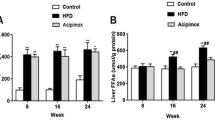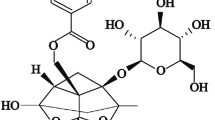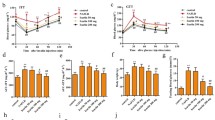Abstract
Non-alcoholic fatty liver disease (NAFLD) is the commonest cause of liver morbidity and mortality and has multiple unclear pathogenic mechanisms. Vitamin D deficiency was associated with increased incidence and severity of NAFLD. Increased hepatic expression of 3-mercaptopyruvate sulfur transferase (MPST) and dysregulated hepatocyte apoptosis were involved in NAFLD pathogenesis. We aimed to explore the protective effect of 1,25-Dihydroxycholecalciferol (1,25-(OH)2 D3) against development of NAFLD and the possible underlying mechanisms, regarding hepatic MPST and caspase-3 expression. 60 male adult rats were divided into 4 and 12 week fed groups; each was subdivided into control, high-fat diet (HFD), and HFD + VD. Serum levels of lipid profile parameters, liver enzymes, insulin, glucose, C-reactive protein (CRP), tumor necrosis factor alpha (TNF-α), and hepatic levels of malondialdehyde (MDA), total antioxidant capacity (TAC), and reactive oxygen species (ROS) were measured. BMI and HOMA-IR were calculated, and liver tissues were processed for histopathological and immunohistochemical studies. The present study found that 1,25-(OH)2 D3 significantly decreased BMI, HOMA-IR, serum levels of glucose, insulin, liver enzymes, lipid profile parameters, CRP, TNF-α, hepatic levels of MDA, ROS, hepatic expression of MPST, TNF-α, 8-hydroxy-2′-deoxyguanosine (8-OHdG), and caspase-3; and significantly increased hepatic TAC in both HFD-fed groups. In conclusion: Administration of 1,25-(OH)2 D3 with HFD abolished the NAFLD changes associated with HFD in 4-week group, and markedly attenuated the changes in 12-week group. The anti-apoptotic effect via decrement of caspase-3 and MPST expression are novel mechanisms suggested to be implicated in the protective effect of 1,25-(OH)2 D3.








Similar content being viewed by others
References
Abramovitch S et al (2011) Vitamin D inhibits proliferation and profibrotic marker expression in hepatic stellate cells and decreases thioacetamide-induced liver fibrosis in rats. Gut 60(12):1728–1737
Alexander M et al (2018) Real-world data reveal a diagnostic gap in non-alcoholic fatty liver disease. BMC Med 16(1):p130
Aravinthan A et al (2013) Hepatocyte senescence predicts progression in non-alcohol-related fatty liver disease. J Hepatol 58(3):549–556
Artaza JN, Norris KC (2009) Vitamin D reduces the expression of collagen and key profibrotic factors by inducing an antifibrotic phenotype in mesenchymal multipotent cells. J Endocrinol 200:207–221
Asalah AK et al (2014) Serum Resistin, Vaspin and Chemerin in rats with non-alcoholic fatty liver disease: correlation with metabolic and haemostatic parameters. Basic Sci Med 3(4):69–84
Barchetta I et al (2013) Hypovitaminosis D is independently associated with metabolic syndrome in obese patients. PLoS ONE 8(7):p68689
Barchetta I et al (2017) Vitamin D supplementation and non-alcoholic fatty liver disease: present and future. Nutrients 9:p1015
BİngÜl I et al (2021) The effect of 1,25-dihydroxyvitamin D3 on liver damage, oxidative stress and advanced glycation end products in experimental nonalcoholic- and alcoholic- fatty liver disease. Turk J Med Sci. https://doi.org/10.3906/sag-2007-289
Charoenngam N, Holick MF (2020) Immunologic effects of vitamin d on human health and disease. Nutrients 12:p2097
Cimini FA et al (2019) Overview of studies of the vitamin D/vitamin D receptor system in the development of non-alcoholic fatty liver disease. World J Gastrointest Pathophysiol 10:11–16
Codogno P, Meijer AJ (2010) Autophagy: a potential link between obesity and insulin resistance. Cell Metab 11:449–451
Das SK, Balakrishnan V (2011) Role of cytokines in the pathogenesis of non-alcoholic Fatty liver disease. Indian J Clin Biochem 26:202–209
Duan P et al (2016) 4-Nonylphenol induces apoptosis, autophagy and necrosis in sertoli cells: involvement of ROS-mediated AMPK/AKT-mTOR and JNK pathways. Toxicology 341:28–40
Eliades M, Spyrou E (2015) Vitamin D: a new player in non-alcoholic fatty liver disease? World J Gastroenterol 21(6):1718–1727
Elseweidy MM et al (2017) Vitamin D3 intake as regulator of insulin degrading enzyme and insulin receptor phosphorylation in diabetic rats. Biomed Pharmacother 85:155–159
Eslam M et al (2020) A new definition for metabolic dysfunction-associated fatty liver disease: An international expert consensus statement. J Hepatol 73:202–209
European Association for the Study of the Liver (EASL) et al (2016) Clinical Practice Guidelines for the management of non-alcoholic fatty liver disease. Diabetologia 59(6):1121–1140
Farhangi MA et al (2017) Adipose tissue inflammation and oxidative stress: the ameliorative effects of vitamin D. Inflammation 40(5):1688–1697
Foroughi M et al (2016) The effect of vitamin D supplementation on blood sugar and different indices of insulin resistance in patients with nonalcoholic fatty liver disease (NAFLD). Iran J Nurs Midwifery Res 21:1000–1004
Freitas RB et al (2016) Euterpe edulis extract but not oil enhances antioxidant defenses and protects against nonalcoholic fatty liver disease induced by a high-fat diet in rats. Oxid Med Cell Longev 2016:p8173876
Friedwald WT et al (1972) Estimation of the concentration of low-density lipoprotein cholesterol in plasma, without use of the preparative ultracentrifuge. Clin Chem 18:499–502
Genc H et al (2013) Association of plasma visfatin with hepatic and systemic inflammation in nonalcoholic fatty liver disease. Ann Hepatol 12:548–555
Gode ST et al (2016) Effect of vitamin D deficiency on the development of postoperative atrial fibrillation in coronary artery bypass patients. J Cardiovasc Thorac Res 8(4):140–146
Golmohammadi MG et al (2020) Vitamin D3 and erythropoietin protect against renal ischemia-reperfusion injury via heat shock protein 70 and microRNA-21 expression. Sci Rep 10(1):p20906
Gujral JS et al (2001) Mechanism of cell death during warm hepatic ischemia reperfusion in rats: apoptosis or necrosis. Hepatology 33(2):397–405
Hadizadeh F et al (2017) Nonalcoholic fatty liver disease: diagnostic biomarkers. World J Gastrointest Pathophysiol 8(2):11–26
Han H et al (2015) A role of 1,25(OH)2D3 supplementation in rats with nonalcoholic steatohepatitis induced by choline-deficient diet. Nutr Metab Cardiovasc Dis 25:556–561
Hariri M, Zohdi S (2019) Effect of Vitamin D on non-alcoholic fatty liver disease: a systematic review and meta-analysis of randomized controlled clinical trials. Int J Prev Med 11(11):10–14
Ionica M et al (2020) Vitamin D alleviates oxidative stress in adipose tissue and mesenteric vessels from obese patients with subclinical inflammation. Can J Physiol Pharmacol 98:85–92
Jahn D et al (2019) Beneficial effects of vitamin D treatment in an obese mouse model of non-alcoholic steatohepatitis. Nutrients 11(1):p77
Kleiner DE et al (2005) Design and validation of a histological scoring system for nonalcoholic fatty liver disease. Hepatology 41:1313–1321
Lee J et al (2017) High-normal levels of hs-CRP predict the development of non-alcoholic fatty liver in healthy men. PLoS ONE 12(2):p172666
Li J et al (2016) The role of vitamins in the pathogenesis of non-alcoholic fatty liver disease. Integr Med Insights 11:19–25
Li M et al (2018) Fatty acids promote fatty liver disease via the dysregulation of 3 mercaptopyruvate sulfurtransferase/hydrogen sulfide pathway. Gut 67(12):2169–2180
Lim H et al (2021) Effect of vitamin D3 supplementation on hepatic lipid dysregulation associated with autophagy regulatory AMPK/Akt-mTOR signaling in type 2 diabetic mice. Exp Biol Med (maywood) 246(10):1139–1147
Liu HY et al (2009) Hepatic autophagy is suppressed in the presence of insulin resistance and hyperinsulinemia: inhibition of FoxO1-dependent expression of key autophagy genes by insulin. J Biol Chem 284:31484–31492
Liu L et al (2016) Therapeutic effects of 1, 25-dihydroxyvitamin D3 on diabetes-induced liver complications in a rat model. Exp Ther Med 11(6):2284–2292
Liu Y et al (2020) Active vitamin D supplementation alleviates initiation and progression of nonalcoholic fatty liver disease by repressing the p53 pathway. Life Sci 241:p117086
Lonardo A et al (2018) A round trip from nonalcoholic fatty liver disease to diabetes: molecular targets to the rescue? Acta Diabetol 56(4):385–396
Luo ZL et al (2014) Effects of treatment with hydrogen sulfide on methionine–choline deficient diet-induced non-alcoholic steatohepatitis in rats. J Gastroenterol Hepatol 29:215–222
Mani S et al (2014) Hydrogen sulfide and the liver. Nitric Oxide 41:62–71
Mantovani A et al (2018) Association between nonalcoholic fatty liver disease and colorectal tumours in asymptomatic adults undergoing screening colonoscopy: a systematic review and meta-analysis. Metabolism 87:1–12
Mason C et al (2014) Vitamin D3 supplementation during weight loss: a double-blind randomized controlled trial123. Am J Clin Nutr 99:1015–1025
Matthews DR et al (1985) Homeostasis model assessment: insulin resistance and-cell function from fasting plasma glucose and insulin concentrations in man. Diabetologia 28:412–419
Moschen AR et al (2010) Anti-inflammatory effects of excessive weight loss: potent suppression of adipose interleukin 6 and tumour necrosis factor alpha expression. Gut 59:1259–1264
Nakano T et al (2011) Impact of artificial sunlight therapy on the progress of non-alcoholic fatty liver disease in rats. J Hepatol 55(2):415–425
Neuschwander-Tetri BA (2010) Hepatic lipotoxicity and the pathogenesis of nonalcoholic steatohepatitis: the central role of nontriglyceride fatty acid metabolites. Hepatology 52:774–788
Niederreiter L, Tilg H (2018) Cytokines and fatty liver diseases. Liver Res 2:14–20
Norris EJ et al (2011) The liver as a central regulator of hydrogen sulfide. Shock 36:242–250
Novelli E et al (2007) Anthropometrical parameters and markers of obesity in rats laboratory animals Ltd. Lab Anim 41:111–119
Ore A, Akinloye OA (2019) Oxidative stress and antioxidant biomarkers in clinical and experimental models of non-alcoholic fatty liver disease. Medicina 55:26
Pan Y et al (2012) Colorimetric detection of apoptosis based on caspase-3 activity assay using unmodified gold nanoparticles. Chem Commun (camb) 48:997–999
Peh MT et al (2014) Effect of feeding a high fat diet on hydrogen sulfide (H2S) metabolism in the mouse. Nitric Oxide 41:138–145
Rosso C et al (2019) Crosstalk between adipose tissue insulin resistance and liver macrophages in non-alcoholic fatty liver disease. J Hepatol 71:1012–1021
Sangouni AA et al (2019) A narrative review on effects of vitamin D on main risk factors and severity of non-alcoholic fatty liver disease. Diabetes Metab Syndr 13:2260–2265
Seo YY et al (2013) Tumor necrosis factor-α as a predictor for the development of nonalcoholic fatty liver disease: a 4-year follow-up study. Endocrinol Metab 28:41–45
Sies H (2018) On the history of oxidative stress: Concept and some aspects of current development. Curr Opin Toxicol 7:122–126
Singh R et al (2009) Autophagy regulates lipid metabolism. Nature 458:1131–1135
Sun G et al (2007) Serum visfatin concentrations are positively correlated with serum triacylglycerols and downregulated by overfeeding in healthy young men. Am J Clin Nutr 85(2):399–404
Sun L et al (2015) Hydrogen sulfide reduces serum triglyceride by activating liver autophagy via the AMPK-mTOR pathway. Am J Physiol Endocrinol Metab 309:925–935
Szymczak-Pajor I et al (2020) The molecular mechanisms by which vitamin D prevents insulin resistance and associated disorders. Int J Mol Sci 21:p6644
Tabrizi R et al (2017) The effects of vitamin D supplementation on metabolic profiles and liver function in patients with non-alcoholic fatty liver disease: a systematic review and meta-analysis of randomized controlled trials. Diabetes Metab Syndr 11:975–982
Tilg H, Moschen AR (2010) Evolution of inflammation in nonalcoholic fatty liver disease: the multiple parallel hits hypothesis. Hepatology 52:1836–1846
Tilg H et al (2021) Multiple parallel hits hypothesis in NAFLD—revisited after a decade. Hepatology 73(2):833–842
Timar A et al (2019) Evaluation of the serum prooxidant-antioxidant balance before and after vitamin D supplementation in adolescent Iranian girls. Adv Med Sci 64:174–180
Tomita M et al (2016) Expression of 3-mercaptopyruvate sulfur transferase in the mouse. Molecules 21(12):1707
Toyokuni S et al (1997) Quantitative immunohistochemical determination of 8-hydroxy2’-deoxyguanosine by a monoclonal antibody N45. 1: its application to ferric nitrilotriacetate-induced renal carcinogenesis model. Lab Investig, J Tech Methods Pathol 3:365–374
Wang Y et al (2016) Vitamin D induces autophagy of pancreatic beta-cells and enhances insulin secretion. Mol Med Rep 14:2644–2650
Wiliński B et al (2012) Vitamin D3 (cholecalciferol) boosts hydrogen sulfide tissue concentrations in heart and other mouse organs. Folia Biol (krakow) 60(3–4):243–250
Wilson PWF et al (1985) Estimation of VLDL cholesterol in hyperlipidemia Jr. Clinica Chimico Act 151(285):291
Wu J et al (2002) Involvement of caspase-3 in photoreceptor cell apoptosis induced by in vivo blue light exposure. Invest Ophthalmol vis Sci 43(10):3349–3354
Wu D et al (2015) Exogenous hydrogen sulfide mitigates the fatty liver in obese mice through improving lipid metabolism and antioxidant potential. Med Gas Res 5(1):1
Wu R et al (2016) Change in plasma nesfatin-1 concentration within high-fat diet induced nonalcoholic fatty liver disease rat models. Wei Sheng Yan Jiu 45(3):452–457
Yang Z et al (2015) 1,25(OH)2 D3 protects beta cell against high glucose-induced apoptosis through mTOR suppressing. Mol Cell Endocrinol 414:111–119
Yeniova AO et al (2014) High-sensitivity C-reactive protein is a strong predictor of non-alcoholic fatty liver disease. Hepatogastroenterology 61:422–427
Yilmaz Y (2012) Review article: is non-alcoholic fatty liver disease a spectrum, or are steatosis and non-alcoholic steatohepatitis distinct conditions? Aliment Pharmacol Ther 36(9):815–823
Yin X et al (2017) Association of PI3K/AKT/mTOR pathway genetic variants with type 2 diabetes mellitus in Chinese. Diabetes Res Clin Pract 128:127–135
Yu Y et al (2018) Effect of vitamin D supplementation on some inflammatory biomarkers in type 2 diabetes mellitus subjects: a systematic review and meta-analysis of randomized controlled trials. Ann Nutr Metab 73:62–73
Zhang H et al (2020) Vitamin D receptor targets hepatocyte nuclear factor 4α and mediates protective effects of vitamin D in nonalcoholic fatty liver disease. J Biol Chem 295:3891–3905
Zhong J et al (2017) Irbesartan ameliorates hyperlipidemia and liver steatosis in type 2 diabetic db/db mice via stimulating PPAR-gamma, AMPK/akt/mTOR signaling and autophagy. Int Immunopharmacol 42:176–184
Zhu C et al (2017) Active form of vitamin D ameliorates non-alcoholic fatty liver disease by alleviating oxidative stress in a high-fat diet rat model. Endocrine J 64(7):663–673
Acknowledgements
Great appreciation to the Image Analysis Unit of the Human Anatomy and Embryology Department, Zagazig University for executing the histopathological and morphometrical studies.
Funding
This research did not receive any specific grant from funding agencies in the public, commercial, or not-for-profit sectors.
Author information
Authors and Affiliations
Contributions
MAH prepared the design, interpretation of the studies, analysis of the data and wrote the manuscript; MAH and DAH conducted the experiments, AEA performed the histological, and immunohistochemical and morphometrical studies and analyzing them, MNI revised the manuscript, AAK and MAH revised and prepared the manuscript for publications.
Corresponding author
Ethics declarations
Conflict of interest
The authors declared no potential conflicts of interest with respect to the research, authorship, and/or publication of this manuscript.
Ethical approval
All procedures were carried out in accordance with guidelines of IACUC (Institutional Animal Care and Use Committee), Zagazig University, Egypt.
Additional information
Publisher's Note
Springer Nature remains neutral with regard to jurisdictional claims in published maps and institutional affiliations.
Rights and permissions
Springer Nature or its licensor (e.g. a society or other partner) holds exclusive rights to this article under a publishing agreement with the author(s) or other rightsholder(s); author self-archiving of the accepted manuscript version of this article is solely governed by the terms of such publishing agreement and applicable law.
About this article
Cite this article
Ibrahim, M.N., Khalifa, A.A., Hemead, D.A. et al. 1,25-Dihydroxycholecalciferol down-regulates 3-mercaptopyruvate sulfur transferase and caspase-3 in rat model of non-alcoholic fatty liver disease. J Mol Histol 54, 119–134 (2023). https://doi.org/10.1007/s10735-023-10118-9
Received:
Accepted:
Published:
Issue Date:
DOI: https://doi.org/10.1007/s10735-023-10118-9




